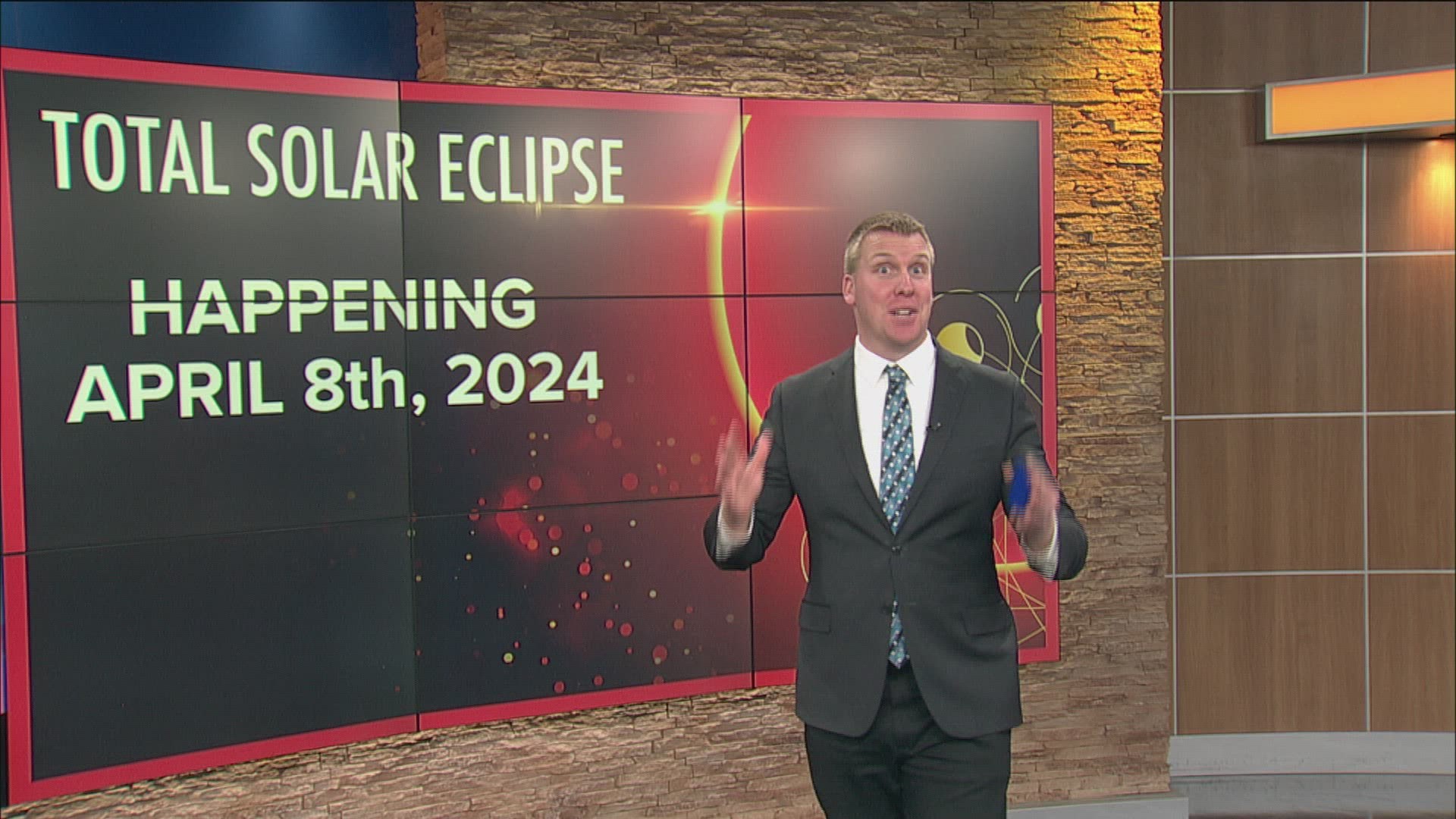TOLEDO, Ohio —
How will the 2024 total solar eclipse compare to 2017 eclipse
A total eclipse is a rare event; often, hundreds of years pass between moon shadow passes in any one location. That a total solar eclipse will cross the United States for the second time in seven years is a lucky opportunity.
A total solar eclipse is no stranger to recent history in the U.S. The Aug. 21, 2017 total solar eclipse entered the U.S. on the west coast in Oregon and exited in South Carolina. Though also a total eclipse, the April 8 solar eclipse will take a different path. The path of totality will come ashore in Mexico, crossing the Del Rio in Texas and taking a track through Maine.
Overlaying these two paths give a lucky few in the heartland who can boast that they were in the path of two total eclipses in less than a decade. However, the 2024 eclipse will be different in one significant way from its 2017 sibling: the length of time for the eclipse.
The 2017 eclipse featured a maximum eclipse residence time of 2 minutes and 30 seconds. This time around, some areas will see totality for over a whopping four minutes.

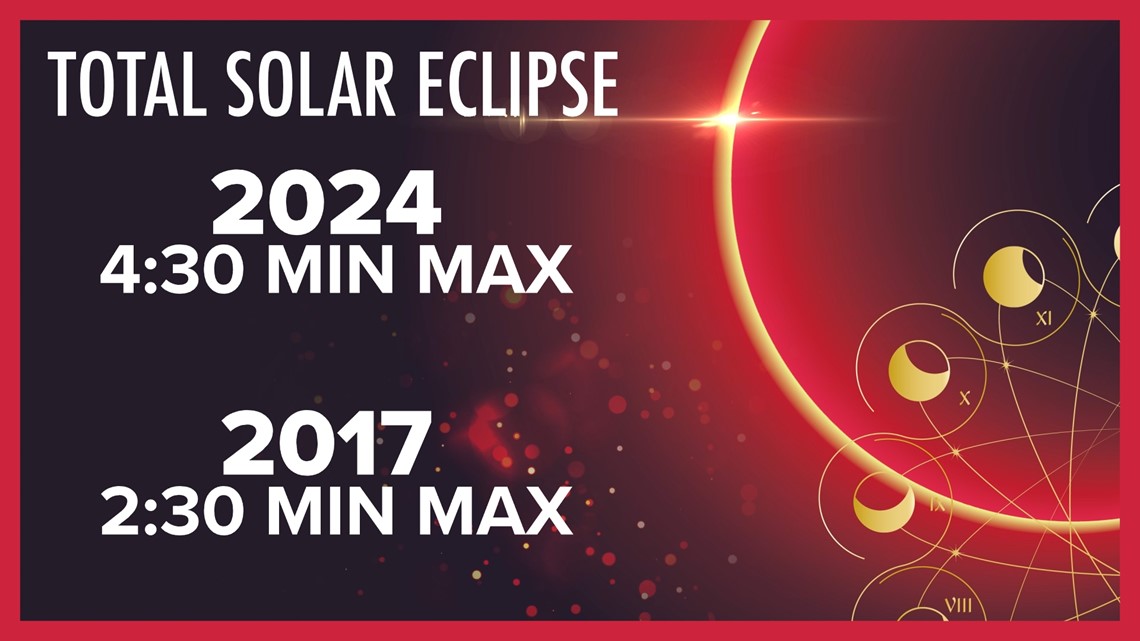
Eclipse events use to have a very different meaning
Because eclipses can be both predicted and retroactively calculated, scientists are able to match historical documents and depictions with eclipses that would have occurred at a given time.
Thanks to modern astronomy advances, scientists and sky-watchers alike understand an eclipse is simply the shadow produced when the moon passes in front of the sun. Historians have found that previous civilizations across the globe interpreted eclipses in a variety of ways, including as religious symbols or omens.
For example, per NASA, ancient Chinese civilizations thought an eclipse was a celestial dragon devouring the sun. In ancient Greece, a solar eclipse during a battle between the Medes and the Lydians supposedly caused both sides to put down their weapons, according to historians.
In the tomb of Ramses V and Ramses VI in Egypt, a mural may be the earliest known depiction of a solar eclipse.
This is not to say, however, that many of these same civilizations did not simultaneously have astronomers hard at work mapping the skies: in the fourth century BC, astronomer Shi Shen described the prediction of eclipses using relative positions of the moon and sun.
Similarly, Greek astronomer Ptolemy demonstrated a sophisticated understanding of both lunar and solar eclipses in the second century AD.
How one eclipse changed our understanding of the universe
On an international level, total solar eclipses have provided excellent insight to some of science's greatest minds.
Famous physicist Albert Einstein published his "Theory of Relativity" in 1915, but the scientific community was still working to test and confirm the theory. Many were still skeptical. The chance for proof was given during a total solar eclipse across the southern hemisphere in 1919.
The eclipse was the perfect chance to take photos of stars to see how light is bent, proving Einstein's theory true. Following analysis of the photos, Einstein was vindicated and proven correct, revolutionizing our understating of space, time and the universe.

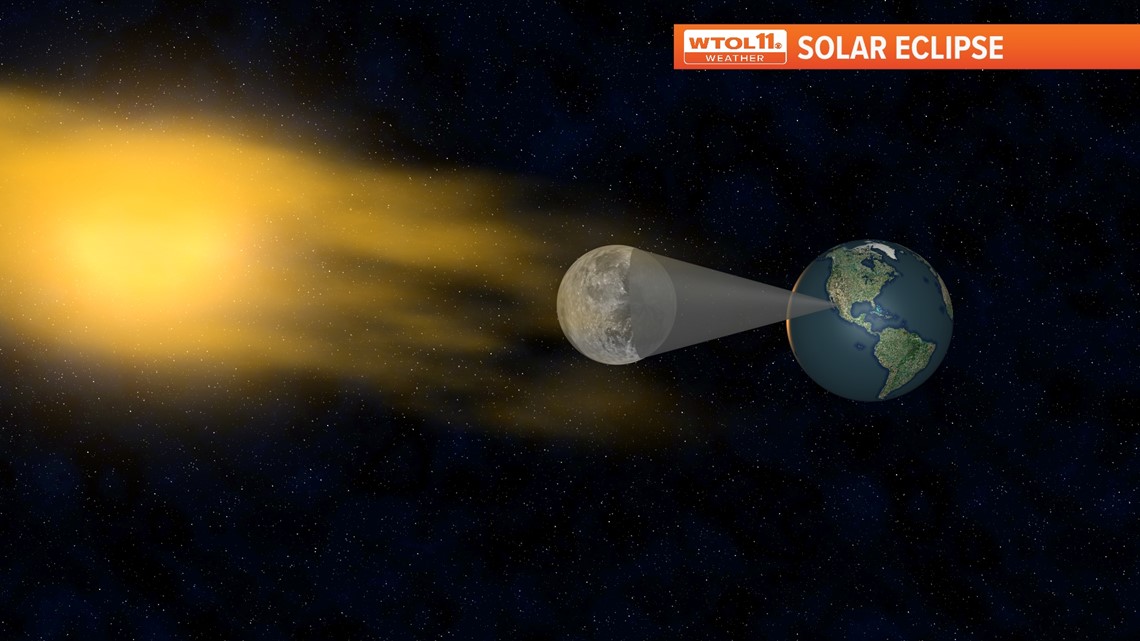
Local history of the eclipse
While northwest Ohio hasn’t seen a total solar eclipse since 1806, several annular and partial eclipses have passed through the area in the last 200 years that are well-documented.
The June 16, 1806 total solar eclipse plays an important role in Ohio history. The late University of Toledo professor and historian Dr. Alfred Cave chronicled the story of a Native American religious leader who used the eclipse to solidify claims he was a prophet. In his book, "Prophets of the Great Spirit," Cave writes extensively about Shawnee chief and warrior Tecumseh’s brother, Tenskwatawa, who led a religious and political movement among Shawnee Native Americans.
Tenskwatawa claimed he was a prophet and led what historians describe as a purification movement among the Shawnee. Then-governor of the Indiana Territory and later short-lived president William Henry Harrison was skeptical of Tenskwatawa's claims.
“If he really is a prophet,” Harrison wrote, “ask him to cause the sun to stand still—the moon to alter its course—the rivers to cease to flow—or the dead to arise from their graves. If he does these things, you may then believe that he has been sent from God.”
Tenskwatawa, who was residing near Greenville, Ohio at the time, took the challenge. According to Cave, he predicted the sun would turn black on June 16, 1806. This date, of course, coincided with a total solar eclipse, greatly increasing Tenskwatawa’s reputation among his followers.

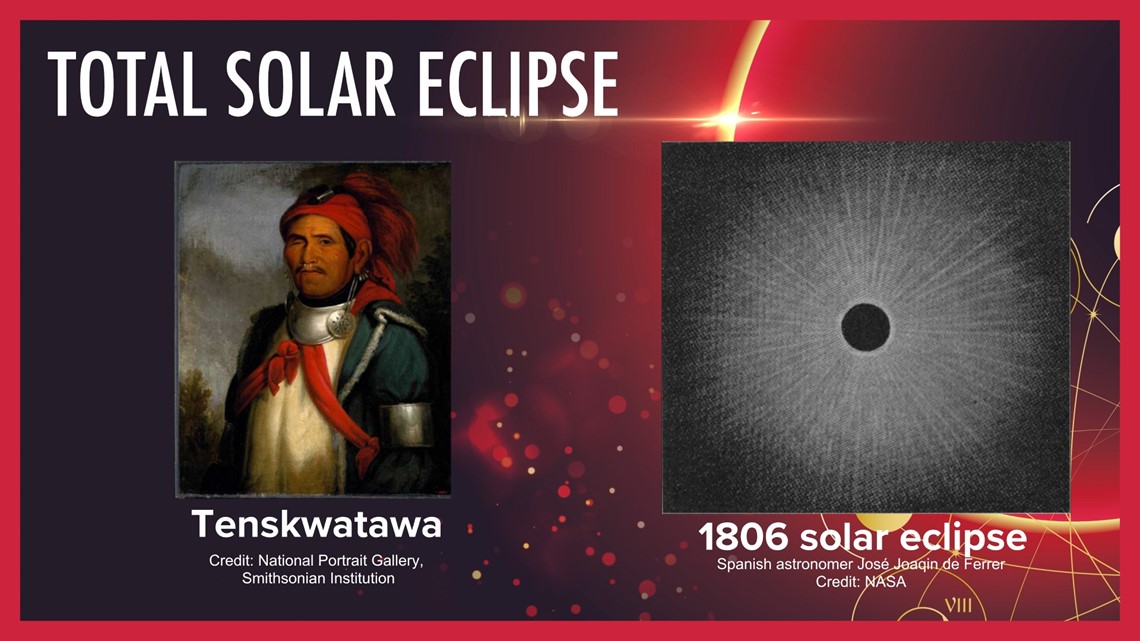
Some scholars have postulated that Tenskwatawa correctly predicted the eclipse using knowledge obtained by Tecumseh, who may have learned of the eclipse from American scientists coming to Ohio to view it.
In 1831, the Sandusky Clarion included a small newspaper clip taken from the Geneva Gazette, a New York-based newspaper which would have seen a total eclipse that day.
“Great Solar Eclipse. On the 12th of February 1831, there will be a great eclipse of the sun, visible to us. At 11h. 26m. A. M. a small black dent will appear on the side of the sun, which will increase to the middle of the eclipse, when only a small edge of light extending beautifully down on each side will be vissible [sic]. The whole duration will be 3h. 1m. The darkness will be so great that the largest stars will appear, and gloom and obscurity will shade terrestrial things.”
Regarding a total solar eclipse on Aug. 7, 1869, which would have been only partially visible in Ohio, Columbus newspaper “Daily Ohio Statesman” wrote:
“The peculiarities attaching to an eclipse of the magnitude of that of Saturday, were observable to a marked degree, but it did not reach the limit which sends the chickens to roost and starts the birds to their resting places in the tree tops. The peculiar leaden hue of the atmospheric surroundings, with a marked falling of temperature arrested the attention of some who for the first time thought of the procuring cause, and were eager hunters after smoked glass, with which to observe the phenomena.”
The “smoked glass” the author mentions appears to reference a means with which people attempted to safely view the solar eclipse at a time when solar protective gear was not available.

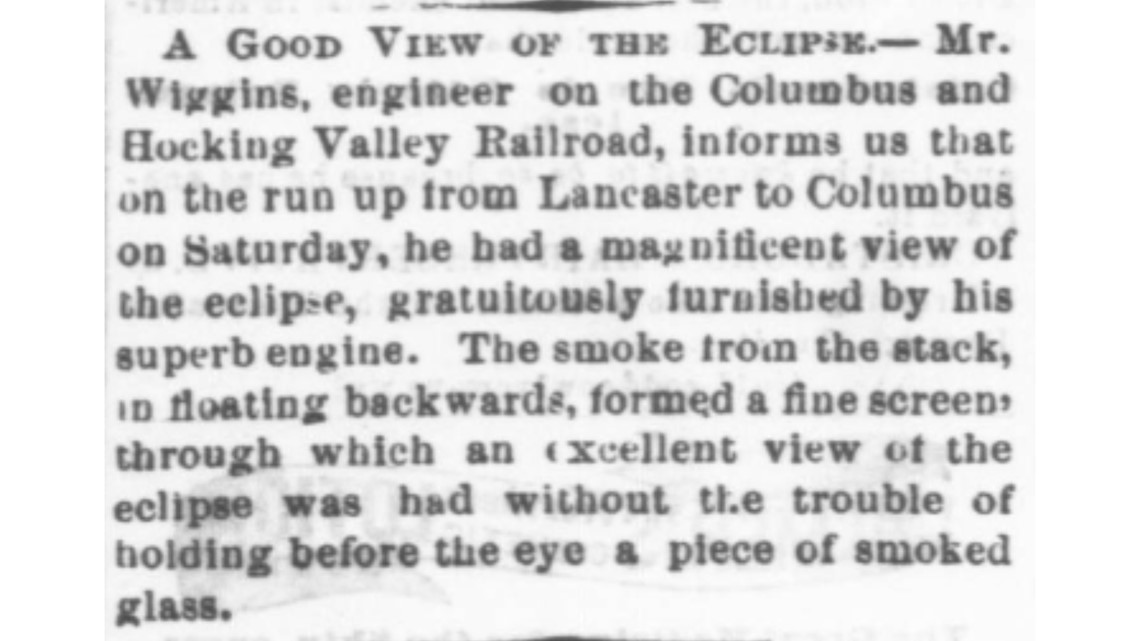
The newspaper also makes mention of a “tin pipe, about five feet in length, and three inches diameter,” in which the word “SOLD” was cut from a piece of tin. According to the newspaper, those who had paid for this object had been conned—no eclipse could be seen through it.
The Cadiz Sentinel of Cadiz, Ohio also commented on the 1831 eclipse. To protect a viewer’s eyes, the editor recommended that people only view a solar eclipse through “one of the very darkest green or red glasses of a sextant, and in default of this, a piece of common window glass, free from veins, and rendered quite black by the smoke of a lamp.”

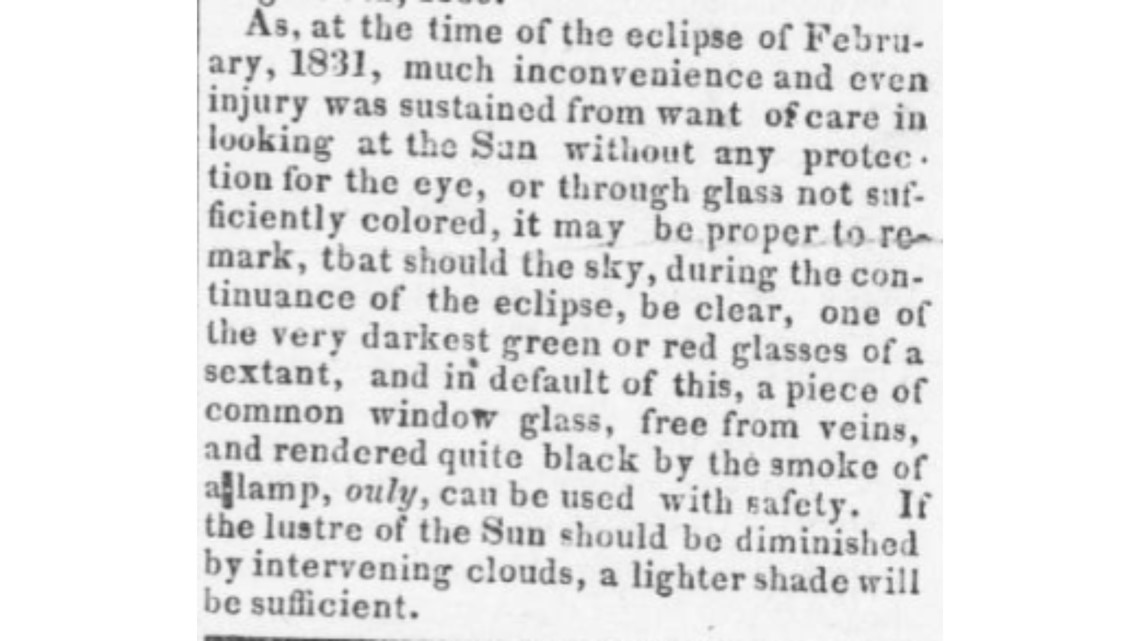
Needless to say, viewing a solar eclipse without protective gear can be extremely dangerous; improper viewing can cause blindness. While early Ohioans may have used smoked glass and faulty tin telescopes, please only use solar eclipse protective glasses.
The editor of the “Statesman” also commented on the infrequency of total solar eclipses.
“Thus it appears that more persons living in the United States have had a view of Niagara Falls, or of the Mammoth Cave of Kentucky, than have ever witnessed the grand astronomical phenomenon of a total eclipse of the sun,” they wrote.
When will the next eclipse happen here?
If you miss out this time at the total eclipse on our backyard, you’ll have to travel to ever see another eclipse. That’s because the next one locally won’t be until 2099.

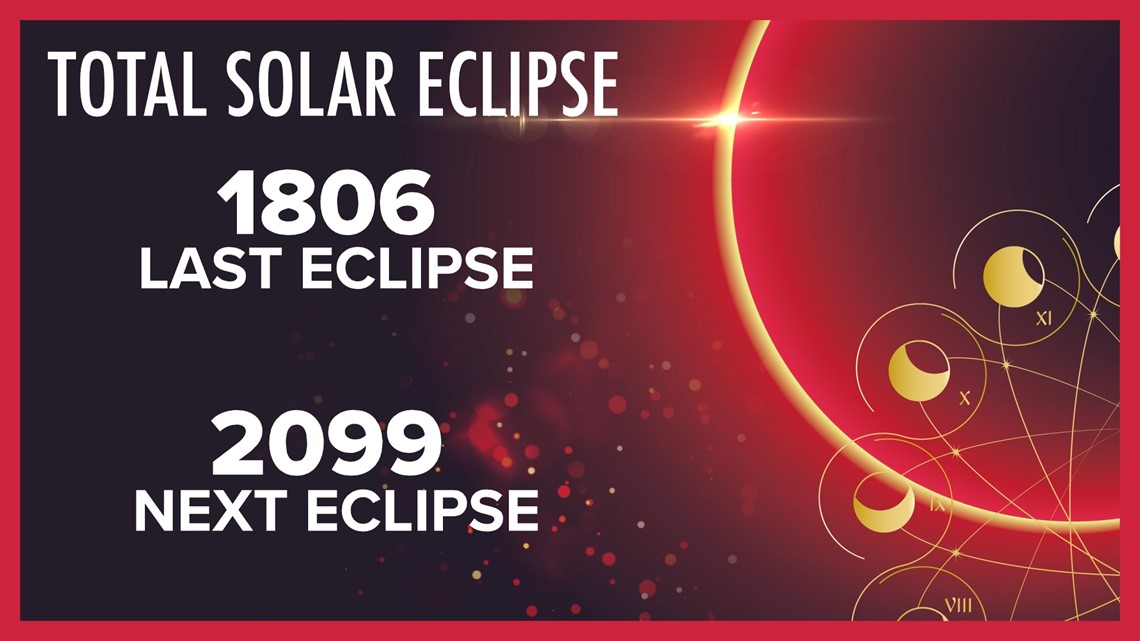
List of eclipses visible from Toledo in the last 200 years
June 16, 1806 Total
Sept. 17, 1811 Annular
Sept. 18, 1838, Annular
May 10, 1994 Annular
MORE 2024 TOTAL SOLAR ECLIPSE COVERAGE FROM WTOL 11

